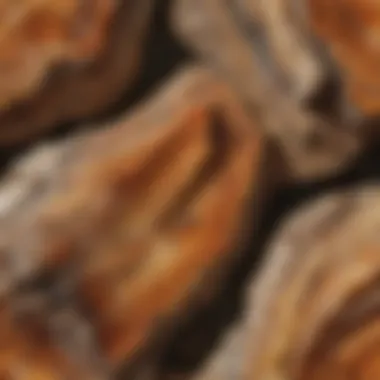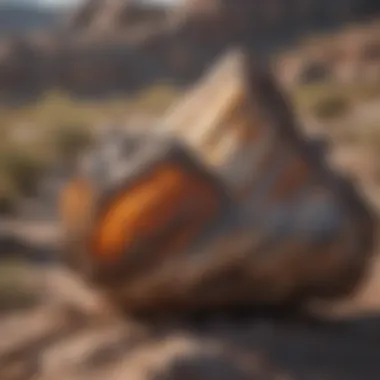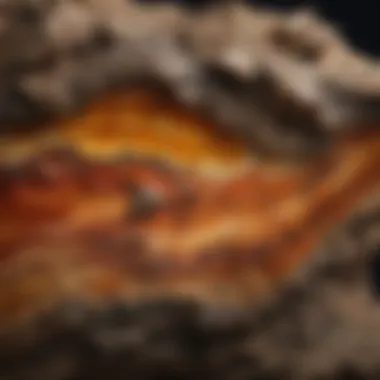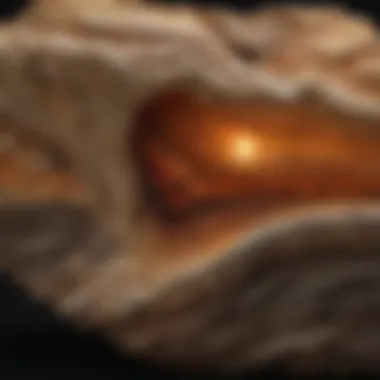Unveiling the Enchanting Mysteries of Petrified Wood Stone


Identifcation and Fossil Rock
Historically, petrified wood has captured the imagination of many with its spellbinding tale of transformation from wood to stone over millennia. When venturing into the realm of petrified wood stone 🌲🪵, discerning collectors may encounter various types of rocks and fossils embedded with ancient secrets waiting to be unveiled. Among these enthralling specimens, keen eyes may identify distinctive characteristics such as intricate wood grain patterns preserved in stone or subtle hues hinting at the prehistoric origins of these geological treasures. To aid in the task of identification, aspiring collectors may utilize specialized tools such as magnifying glasses, scratch tests, and ultraviolet lights to reveal hidden details and confirm the authenticity of petrified wood finds.
Collection Techniques and Tips
Embarking on a journey to gather petrified wood stone requires careful planning and a keen eye for prime collecting sites. Aspiring collectors are advised to research geological maps to pinpoint regions abundant in petrified wood deposits, whether in ancient forests, riverbeds, or volcanic terrain. To responsibly extract specimens without causing damage, collectors should employ techniques such as gentle tapping with rock hammers, chisels, and brushes to uncover and safeguard these ancient remnants. Best practices also include carrying necessary permits and adhering to harvesting regulations to ensure the preservation of these geological wonders for future generations to admire and study.
Preservation and Showcase
Once in possession of petrified wood specimens, enthusiasts may ponder on the optimal ways to preserve and showcase these exquisite remnants of the ancient past 🌿🪵. Employing techniques like coating with protective sealants or storing in archival quality containers shields petrified wood from environmental factors that may degrade its natural splendor over time. For those inclined towards creative display, innovative ideas resonate, incorporating petrified wood pieces in dioramas, jewelry, or custom-built stands that not only showcase these geological marvels but also narrate their wondrous journey from organic matter to mineralized stone, capturing the essence of time frozen in wood.
Geological Revelations
Viewing petrified wood stone extends beyond mere aesthetic appreciation, offering profound insights into Earth's dynamic geological processes over eons of time. Reflecting on the geological formations that encapsulate petrified wood reveals snapshots of ancient ecosystems, climates, and cataclysmic events that shaped our planet's narrative. Delving into the historical significance of petrified wood unveils a chronicle of past life forms, rising and falling of civilizations, and lessons in adaptation and resilience gleaned from the whispering fossils trapped within stone. Noteworthy discoveries in the field continually enrich our understanding of Earth's history and evolution, inspiring rock and fossil enthusiasts to continue unraveling the enigmatic tapestry of the distant past.
Introduction
In delving into the intriguing universe of petrified wood stone, we embark on a journey that unveils a geological masterpiece offering a glimpse into ancient history. This article serves as a profound elucidation of a natural wonder, from its formation to its diverse applications and significance. By dissecting each facet meticulously, readers will glean a comprehensive understanding of this mesmerizing material.
What is Petrified Wood Stone?
Overview of Petrified Wood Stone
Petrified wood stone stands as a testament to time, forged through a fascinating mineralization process that transitions organic matter into stone while preserving intricate wood structures. This petrification metamorphosis captures the essence of ancient forests, showcasing detailed tree rings and bark textures frozen in time. The allure of petrified wood lies in its unique amalgamation of organic beauty with stone resilience, making it a sought-after choice for both geological enthusiasts and designers seeking nature-inspired elements.
Formation Process
The formation of petrified wood stone begins with organic matter submerging in mineral-rich water, where gradual mineral infiltration replaces cell structures with silica, resulting in a flawless stone replica of the original wood. This intricate process, termed permineralization, ensures meticulous preservation of biological features, transforming mundane wood into a geological marvel. Despite its complex formation, petrified wood stone's enduring allure lies in its ability to convey history through petrified remnants, offering a tangible connection to Earth's ancient past.
Historical Significance
Ancient Civilizations and Petrified Wood
Ancient civilizations revered petrified wood for its mystical properties, associating it with resilience, wisdom, and protection. From crafting sacred talismans to embodying spiritual beliefs, civilizations across the globe integrated petrified wood into their cultural tapestry. Its symbolic significance as a bridge between past and present infuses spaces with a timeless aura, inviting contemplation and connection to bygone eras.
Cultural Uses
Exquisite craftsmanship meets cultural symbolism in the utilization of petrified wood stone for intricate sculptures, ceremonial artifacts, and ornamental display. The transcendent beauty of petrified wood is harnessed in cultural practices, blending artistic finesse with geological heritage. By incorporating petrified wood into traditional art forms, artisans honor geological wonders, enriching cultural narratives with enduring stones that embody epochs of history.
Unique Characteristics
Color Variations
Petrified wood stone mesmerizes with its kaleidoscopic hues, reflecting a geological palette ranging from earthy browns to vibrant reds and yellows. These color variations not only illustrate mineral deposition processes but also evoke emotive connections to ancient landscapes. The fusion of vivid tones within petrified wood grants each piece a distinct identity, enticing collectors and designers with a chromatic symphony frozen in time.


Texture and Grain Patterns
The tactile allure of petrified wood stone lies in its intricate grain patterns and textures, reminiscent of tree bark frozen in perpetual motion. These sensory elements invite exploration, encouraging tactile engagement with geological narratives embedded within each polished surface. The interplay of textures and grain patterns amplifies the stone's allure, transforming petrified remnants into tangible testaments of primordial forests.
Formation and Properties
Petrified wood stone stands as a testament to the passage of time and the intricate processes of nature. In this section, we delve deep into the essence of petrified wood stone, exploring its formation and highlighting the key properties that make it a marvel of geological significance. Understanding the formation and properties of petrified wood stone is crucial in unraveling its enigmatic past and appreciating its enduring beauty.
Transformation Process
Permineralization
Permineralization plays a crucial role in the transformation of organic wood into petrified wood stone. This process involves the gradual replacement of the organic material with minerals, resulting in the solidification of wood at a molecular level. The key characteristic of permineralization lies in its ability to retain the intricate cellular structure of the original wood, thus preserving details that have survived thousands of years. Petrified wood stone owes its durability and exquisite patterns to the phenomenon of permineralization, making it a highly sought-after choice for fossil collectors and enthusiasts alike.
Replacement Processes
The replacement processes involved in the petrification of wood offer a unique insight into the formation of petrified wood stone. Through a series of chemical reactions, organic matter is substituted with minerals such as silica, calcite, or pyrite, leading to the solidification of wood over time. The key characteristic of replacement processes lies in their role in maintaining the structural integrity of the original wood while imparting distinctive hues and textures to the petrified wood. While these processes enhance the aesthetic appeal of petrified wood, they also influence its composition, showcasing a blend of organic and inorganic elements that make each piece truly one-of-a-kind.
Chemical Composition
Minerals Involved
The minerals involved in the petrification of wood play a significant role in shaping the characteristics of petrified wood stone. Silica, in particular, acts as a common mineral responsible for replacing the organic material in wood and preserving its texture. Other minerals like calcite and pyrite contribute to the color variations observed in petrified wood, adding to its visual allure. The key characteristic of minerals involved lies in their ability to interact with the organic components of wood, creating a delicate balance between strength and aesthetics in petrified wood stone.
Trace Elements
Trace elements present in petrified wood stone provide valuable insights into the environmental conditions during its formation. Elements like iron, manganese, and copper leave distinct marks in the wood structure, offering clues about the ancient ecosystems where petrified wood originated. The key characteristic of trace elements is their capacity to reveal a narrative of the past, with each element painting a unique picture of the geological history encapsulated in petrified wood. By analyzing these trace elements, researchers can uncover a wealth of information about prehistoric landscapes and climates.
Physical Characteristics
Hardness Scale
The hardness scale of petrified wood stone serves as a testament to its durability and resilience. With a hardness comparable to that of quartz, petrified wood exhibits exceptional resistance to external forces, making it a sought-after material for ornamental purposes. The key characteristic of the hardness scale is its influence on the craftsmanship potential of petrified wood, allowing artisans to sculpt intricate designs while ensuring the longevity of the final piece. Whether used for jewelry making or home decor, the hardness scale of petrified wood underscores its status as a prized material in the world of geology and aesthetics.
Density
The density of petrified wood stone unveils a story of compression and solidification that has taken place over millennia. Characterized by a compact structure, petrified wood showcases a high density that contributes to its weight and tactile texture. The key characteristic of density in petrified wood lies in its ability to offer substantial heft while retaining a polished finish, making it a versatile material for various applications. Whether admiring the intricate patterns or studying the fossilized remains, the density of petrified wood adds a layer of complexity to its allure, inviting exploration and admiration.
Geological Significance
Petrified wood stone holds immense geological significance due to its ability to provide valuable insights into ancient ecosystems and climatic conditions. By studying the petrified wood's structure, researchers can unravel past geological events and understand the processes that led to its formation. This stone serves as a time capsule, preserving crucial information about the Earth's history and evolution. Through careful examination of petrified wood samples using advanced dating techniques and environmental clues, scientists can reconstruct ancient landscapes and deduce the environmental conditions prevalent during the wood's fossilization. Such detailed analysis not only contributes to our understanding of geological processes but also aids in interpreting past climate changes and biodiversity patterns.
Dating Techniques
Carbon Dating
Carbon dating serves as a vital tool in determining the age of petrified wood stone. By analyzing the decay of carbon isotopes within the fossilized remains, researchers can estimate the age of the wood and establish a chronological timeline of its formation. This technique enables scientists to date petrified wood with remarkable accuracy, providing valuable information about its geological history. Despite its efficacy, carbon dating may be influenced by external factors such as contamination or environmental changes, leading to potential inaccuracies in age determination.


Isotopic Analysis
Isotopic analysis plays a key role in understanding the chemical composition of petrified wood and identifying environmental conditions during its formation. By examining stable isotopes within the fossilized material, researchers can infer details about past climates, as different isotopes reflect specific environmental parameters. This method allows scientists to reconstruct the ancient ecosystem in which the petrified wood thrived, offering valuable insights into past ecological dynamics. However, isotopic analysis requires meticulous sample preparation and precise measurements to ensure accurate results, making it a time-intensive but highly informative technique.
Environmental Clues
Paleoclimate Indicators
The study of paleoclimate indicators in petrified wood provides significant information about past climate conditions. Certain features within the fossilized material, such as growth rings or isotopic signatures, can reveal details about past temperature fluctuations and precipitation levels. By analyzing these indicators, scientists can reconstruct ancient climate patterns and assess historical climate variability. Paleoclimate indicators offer a glimpse into the environmental conditions that prevailed during the petrified wood's formation, shedding light on the climatic changes that shaped the Earth's landscapes over millennia.
Ecosystem Insights
Examining ecosystem insights preserved in petrified wood allows scientists to gain a comprehensive understanding of past environmental dynamics. Fossilized pollen, plant remains, and other organic material trapped within the petrified wood offer clues about past ecosystems and biodiversity. By studying these ecological remnants, researchers can piece together the complex interactions between flora and fauna in ancient environments. Ecosystem insights provide valuable data for reconstructing past ecosystems and tracking evolutionary trends, highlighting the interconnectedness of biological communities throughout geological time.
Fossilization Implications
Fossil Preservation
The process of fossil preservation in petrified wood contributes significantly to our knowledge of ancient plant species and their evolutionary history. By studying well-preserved fossil specimens, scientists can identify taxa, understand morphological adaptations, and trace the evolutionary trajectories of extinct plant groups. Petrified wood serves as a medium for fossil preservation, with its mineral-rich structure aiding in the retention of intricate details from the past. Fossil preservation in petrified wood opens a window into ancient forests and allows researchers to reconstruct the plant diversity that once thrived on Earth.
Biostratigraphy
Biostratigraphy, the study of fossilized organisms within geological strata, plays a crucial role in correlating petrified wood deposits with specific geological time periods. By examining the fossil assemblages present in petrified wood samples, scientists can determine the relative age of the deposits and establish stratigraphic sequences. Biostratigraphy helps in creating geological timelines, understanding faunal turnovers, and correlating petrified wood occurrences with global geological events. This method aids in deciphering the evolutionary history of ancient plant communities and provides a framework for interpreting geological formations and environmental changes over time.
Uses and Applications
When delving into petrified wood stone, exploring its uses and applications is paramount to comprehend its significance fully. The versatile nature of petrified wood lends itself well to various purposes, making it a sought-after material in different fields. Understanding how petrified wood can be utilized sheds light on its value beyond its aesthetic appeal. From ornamental to scientific and commercial applications, petrified wood's adaptability is truly remarkable.
Ornamental Purposes
Home Decor
Exploring petrified wood for home decor reveals a unique blend of natural beauty and functionality. Incorporating petrified wood elements into home decor adds a touch of elegance and a rustic charm to living spaces. The rich, earthy tones and intricate grain patterns of petrified wood create a distinct visual appeal that complements various interior styles. Its durability and timeless allure make it a favored choice for interior designers and homeowners alike. While petrified wood can enhance the aesthetics of any space, care must be taken to preserve its integrity, ensuring its longevity in home decor applications.
Jewelry Making
Petrified wood's use in jewelry making showcases its versatility and aesthetic appeal in a wearable form. Crafting jewelry pieces with petrified wood allows for the incorporation of nature's artistic patterns and vibrant colors into personal adornments. The unique textures and patterns of petrified wood make each jewelry piece one-of-a-kind, appealing to those seeking distinctive accessories. Ensuring proper treatment and carving techniques are employed in jewelry making with petrified wood is essential to maintain the stone's integrity and beauty over time.
Scientific Studies
Studying petrified wood for scientific purposes offers a wealth of opportunities for research and exploration. The applications of petrified wood in scientific studies span a wide range of disciplines, from geology to paleobotany. Analyzing the mineral composition and structure of petrified wood provides insights into ancient ecosystems and climatic conditions. Its unique preservation qualities make petrified wood a valuable resource for understanding prehistoric flora and fauna. Incorporating petrified wood specimens in research projects contributes to advancements in geological and biological knowledge, making it an invaluable tool for scientific inquiry.
Research Applications
Utilizing petrified wood in research applications enables scientists to unravel the mysteries of the past and gain comprehensive insights into Earth's history. By studying the petrification process and associated geological features, researchers can reconstruct ancient environments and ecosystems. The data derived from petrified wood samples aids in validating geological theories and refining dating techniques for historical periods. Its significance in research applications extends to archaeological studies, providing a timeline of natural and human activities throughout the ages.
Educational Value


The educational value of petrified wood lies in its ability to engage and inspire students and enthusiasts alike. Using petrified wood specimens as educational tools enriches learning experiences in geology, paleontology, and environmental science. Hands-on activities involving petrified wood promote tactile learning and foster a deeper understanding of geological concepts. Educators leverage the unique characteristics of petrified wood to spark curiosity and stimulate interest in Earth's natural history. Recognizing the educational potential of petrified wood nurtures a sense of stewardship towards our planet's geological heritage.
Commercial Utilization
In the realm of commercial utilization, petrified wood holds a distinct appeal for businesses across various industries. The commercial value of petrified wood stems from its aesthetic qualities and rareness, making it a prized material for artisans and manufacturers. Understanding the market trends and industry insights surrounding petrified wood enables businesses to capitalize on its popularity and demand. From luxury home decor to exclusive jewelry collections, petrified wood products cater to a discerning clientele seeking uniqueness and sophistication.
Market Trends
Analyzing market trends related to petrified wood provides valuable information for businesses involved in its trade. The demand for petrified wood products fluctuates based on consumer preferences, design trends, and economic factors. Keeping abreast of market trends allows suppliers and retailers to adapt their offerings to meet customer expectations and stay competitive in the industry. Identifying niche markets and demographic preferences helps in targeting the right audience and establishing a strong presence in the petrified wood market.
Industry Insights
Exploring industry insights associated with petrified wood sheds light on the production processes, supply chains, and sustainability practices within the industry. Industry players involved in petrified wood extraction, processing, and marketing adhere to stringent quality standards and ethical guidelines to uphold the stone's integrity and value. Understanding the nuances of the petrified wood industry enables stakeholders to make informed decisions regarding sourcing, pricing, and product development. By embracing innovation and environmentally conscious practices, businesses can ensure the long-term viability of petrified wood as a sought-after material in the market.
Preservation and Care
Petrified wood stone, with its rich geological history and unique properties, requires meticulous preservation and care to maintain its pristine condition. Understanding the significance of preservation and care is vital for rock and fossil collectors who value the intricate beauty of this natural wonder. By implementing the right techniques and strategies, collectors can ensure the longevity and visual appeal of their petrified wood specimens.
Maintenance Tips
Cleaning Techniques
When it comes to cleaning petrified wood stone, gentle approaches yield the best results. Utilizing a soft-bristled brush and mild soapy water, collectors can meticulously remove dust and debris without causing any damage to the delicate surface of the specimen. The key characteristic of these cleaning techniques lies in their ability to effectively cleanse the stone without altering its natural color or texture. While traditional cleaning methods may involve harsh chemicals, opting for a more delicate approach ensures the longevity and aesthetic appeal of the petrified wood.
Storage Guidelines
Proper storage plays a crucial role in preserving the integrity of petrified wood stone. Storing these specimens in a cool, dry place away from direct sunlight and extreme temperature fluctuations is essential to prevent deterioration. By following specific guidelines for storage, collectors can protect the stone from environmental factors that may compromise its structural integrity. The unique feature of these storage guidelines lies in their capacity to maintain the beauty and durability of petrified wood over time, ensuring that each specimen remains a testament to its geological past.
Preventing Damage
To safeguard petrified wood stone from potential harm, collectors must proactively implement measures to prevent damage. By understanding the impact of exposure and implementing protective strategies, collectors can preserve the integrity of their specimens for future generations. Preventing damage not only safeguards the physical appearance of the stone but also ensures that its historical significance remains intact.
Avoiding Exposure
Shielding petrified wood stone from prolonged exposure to sunlight and moisture is paramount in maintaining its visual allure. The key characteristic of avoiding exposure lies in its ability to protect the stone from discoloration and potential structural weaknesses that may arise from environmental elements. By minimizing contact with harmful agents, collectors can uphold the natural beauty of petrified wood for years to come.
Protection Measures
Implementing protection measures, such as barrier coatings and display cases, can offer an additional layer of defense against external threats. These measures act as a shield against physical abrasions and UV damage, preserving the aesthetics and structural integrity of the stone. The unique feature of protection measures lies in their proactive approach to conservation, ensuring that each petrified wood specimen retains its allure and historical significance.
Conclusion
In the realm of petrified wood stone, the conclusion serves as the culmination of our exploration, encapsulating the essence of this unique geological material. This concluding segment contextualizes the significance of petrified wood stone within the broader scientific and cultural landscapes. By reflecting on the key aspects discussed throughout the article – from its formation processes to its diverse applications – we gain a comprehensive perspective on the enduring relevance of petrified wood stone. As a time capsule of nature's wonders, petrified wood stone invites us to unravel the mysteries of ancient ecosystems and understand the intricate processes that have shaped our planet over millions of years. In delving into the wonders of this petrified treasure, we not only embrace its intrinsic beauty but also foster a deeper appreciation for the Earth's geological history.
Appreciating Nature's Time Capsule
Eternal Beauty of Petrified Wood
Within the vast tapestry of petrified wood stone lies the eternal beauty that mesmerizes both enthusiasts and scholars alike. The ethereal allure of petrified wood manifests in its exquisite color variations, intricate grain patterns, and remarkable durability. This eternal beauty stands as a testament to the intricate transformation processes that have preserved ancient wood structures through the ages, crystallizing nature's artistry in stone. The enduring allure of petrified wood's beauty transcends mere aesthetics, offering a tangible connection to bygone eras and showcasing the resilience of organic matter through geological time. Whether adorning a tabletop or adorning oneself in the form of jewelry, the eternal beauty of petrified wood stone encapsulates a harmonious blend of natural history and artistic appeal, enriching our lives with its timeless elegance.
Continued Fascination
Amidst the vast expanse of geological wonders, the continued fascination with petrified wood stone endures as a testament to its enduring allure. The legacy of fascination surrounding petrified wood stems from its ability to encapsulate the mysteries of ancient forests within its petrified fibers, offering a tangible link to primordial landscapes long lost to time. The magnetic appeal of petrified wood's continued fascination lies in its ability to spark curiosity, inspire scientific inquiry, and ignite artistic interpretations that span across disciplines and generations. By embodying the enduring charm of natural phenomena frozen in time, petrified wood stone continues to captivate hearts and minds, beckoning us to delve deeper into the enigmatic realms of Earth's geological past and embracing the wonders that lie within its ancient embrace.







